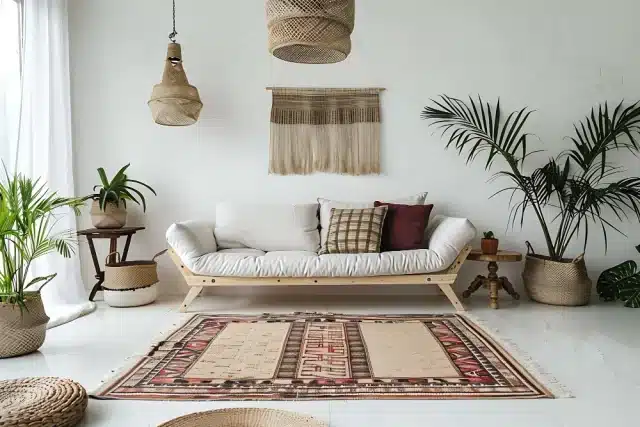Designing a room with depth can make even the smallest space feel larger, more dynamic, and visually interesting. Rooms that lack depth can often feel flat and one-dimensional, but by incorporating layers, textures, colors, and smart decor strategies, you can create a sense of richness and dimension. Whether you’re looking to enhance a cozy living room or make a bedroom feel more expansive, here’s your guide for adding depth to any room.
- Use Contrasting Colors
Color is a powerful tool for adding depth to any space. Darker colors tend to recede, while lighter colors come forward, creating the illusion of depth. By incorporating contrasting colors throughout the room, you can make walls feel farther away, ceilings feel higher, or certain areas stand out.
For example, painting an accent wall in a darker shade can make it seem farther back, which adds depth to the room. You can also use contrasting colors on furniture, artwork, and accessories to create visual interest. A light-colored sofa with dark throw pillows and one of the available patterned 5 by 14 area rugs or a dark blue bedspread with white pillows can create a sense of dimension and prevent the room from feeling flat.
- Play with Light and Shadows
Lighting plays a crucial role in creating depth and ambiance in a room. Instead of relying solely on overhead lighting, layer different light sources throughout the space to create a play of light and shadows, which adds depth. Combine floor lamps, table lamps, and wall sconces to create multiple levels of lighting, ensuring that different areas of the room are highlighted.
You can also strategically use natural light to enhance depth. Placing mirrors opposite windows allows light to reflect and bounce around the room, making it feel larger and more open. Additionally, adjustable lighting, such as dimmable bulbs or movable spotlights, lets you control the mood and focal points, giving you more versatility in how you present depth in your space.
- Incorporate Large-Scale Art or Mirrors
Large-scale artwork or oversized mirrors are a great way to introduce a sense of depth to a room. Artwork with rich, layered details can draw the eye and create a focal point, making the space feel more expansive. Choose art pieces that have strong visual interest, whether through abstract patterns, scenic landscapes, or textures that create the illusion of layers.
Mirrors, on the other hand, are an excellent trick for opening up small spaces and creating depth. A large mirror can reflect light and give the impression that the room extends beyond its actual boundaries. You can also place a mirror on a wall perpendicular to a window to capture and reflect natural light, making the room feel brighter and deeper.
- Layer Furniture and Decor
Arranging furniture and decor in a layered way adds dimension to the room by creating different visual planes. Instead of pushing all furniture against the walls, try pulling some pieces toward the center of the room to create more depth. For example, a floating sofa placed a few feet away from the wall with a console table behind it adds dimension and offers more opportunities for decor layering.
You can also layer smaller decor items, such as placing books, vases, and sculptures at different heights on shelves or tables. This staggered arrangement creates a sense of depth as the eye moves across the various layers of decor.
- Add Depth with Wall Treatments
Walls are a great opportunity to create depth in a room. Instead of leaving walls flat and featureless, consider adding wall treatments like wainscoting, beadboard, or wallpaper with textured patterns. These elements not only add interest but also give the walls a layered, three-dimensional look.
Paneling or wood slats can give a room a sophisticated and textured backdrop, while bold wallpaper with a dynamic pattern can make a smaller room feel more engaging. If you prefer a more minimalist approach, opt for a subtle texture, like grasscloth wallpaper, that adds depth without overwhelming the space.
- Use Furniture with Varied Heights
Incorporating furniture of different heights adds layers and variety to the room, creating visual depth. Low-profile furniture combined with taller pieces allows the eye to move naturally across the room, adding interest and a sense of scale.
For example, pair a low coffee table with a tall bookshelf or a high-backed chair with a shorter side table. This variation in height prevents the room from feeling monotonous and creates a sense of movement and flow. Mixing furniture heights also breaks up the space and gives the illusion that the room has more dimension than it actually does.
- Introduce Patterns and Prints
Patterns and prints are an excellent way to add depth and personality to a room. They create visual complexity and encourage the eye to explore different areas of the space. Incorporate patterns through textiles like rugs, throw pillows, and curtains, or use patterned wallpaper or upholstered furniture.
A mix of large and small patterns can add contrast and depth without overwhelming the room. For example, a patterned area rug paired with solid-colored furniture adds visual interest to the floor, while a patterned accent chair or throw pillow can create focal points that guide the eye through the room.
- Create Focal Points
Depth can also be achieved by creating focal points that draw attention. In any room, it’s important to have one or more elements that immediately catch the eye. These focal points can be anything from a bold piece of artwork to a fireplace or a statement piece of furniture.
Once you’ve established a focal point, arrange the rest of the room around it to highlight and enhance the sense of depth. Surround the focal point with complementary decor that doesn’t compete for attention but rather supports the main feature. This method will naturally create layers of interest and draw the viewer deeper into the space.
To Conclude
Adding depth to any room is all about creating layers, mixing textures, and using strategic design choices that enhance the room’s visual interest. By layering textures, playing with contrasting colors, incorporating large-scale art or mirrors, and using lighting to create shadows, you can make any space feel richer and more dynamic. Whether you’re working with a small room or an expansive open floor plan, these techniques will help you create a space that feels both inviting and visually stimulating.

Speaks from heart, always too passionate and driven by emotions. Spins the words with kindness & sharpness, intriguing your ever-inscrutable minds.




